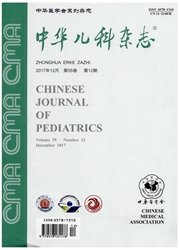

 中文摘要:
中文摘要:
目的探讨维甲酸(RA)对高氧肺损伤保护作用机制及其与调控丝裂原活化蛋白激酶(MAPKs)关系。方法建立高氧(85%)暴露早产SD大鼠肺损伤模型,运用RT—PCR方法检测基质金属蛋白酶2.9(MMP-2、-9)mRNA表达,采用明胶酶谱法检测MMP-2和MMP-9酶原及活酶表达,采用Westemblot技术检测磷酸化和非磷酸化总的ERK1/2、JNK1/2和p38蛋白质表达。结果与空气组比较,高氧暴露4、7、14d,MMP-2和MMP-9mRNA的表达均显著提高(P均〈0.01),MMP-2活酶(除4d外)、MMP-9酶原及活酶的表达明显上调(P〈0.05或P〈0.01),磷酸化ERK1/2、JNK1/2和p38表达显著增加(P均〈0.01);与高氧组比较,4、7、14d时,RA明显下调高氧暴露后MMP-2(除14d外)、MMP-9mRNA的表达(P〈0.01或P〈0.05),不同程度降低MMP-2活酶、MMP-9酶原及活酶的表达和显著下调磷酸化JNK1/2、p38水平,进一步上调磷酸化ERK1/2表达。结论高氧暴露显著提高MMP-2和MMP-9表达,是造成肺损伤的重要因素;JNK1/2和p38信号途径可能参与了高氧暴露下早产大鼠肺组织MMP-2和MMP-9的表达调控;RA可通过降低JNK1/2和p38磷酸化水平,抑制MMP-2和MMP-9的高表达和活化,从而发挥高氧肺损伤保护作用。
 英文摘要:
英文摘要:
Objective To further investigate the protective effect of retinoic acid (RA) on hyperoxia induced lung injury and the role of RA as a modulator on mitogen-activated protein kinases (MAPKs). Methods Establishment of hyperoxia (85%) induced lung injury model of premature Sprague- Dawley (SD)rats: 21 d gestational age SD rat's fetuses (term = 22 d) were delivered by hysterectomy. Within 12-24 h after birth, the premature rat pups were randomly divided into 4 groups: Group Ⅰ , airexposed control group; Group Ⅱ, hyperoxia-expoeed group; GroupⅢ, air plus RA-exposed group, Group Ⅳ, hyperoxia plus RA-exposed group. Group Ⅰ and Ⅲ were remained in room air, and group Ⅱ and Ⅳ were placed in 85% oxygen. The pups in Group Ⅲ and Ⅳ were injected with RA (500 μg/kg, every day) intraperitoneally. The entire lung tissues of premature rat pups were collected at 4 d, 7 d and 14 d. The mRNA levels of MMP-2 and MMP-9 were detected by semi-quantitative reverse transcription polymerase chain reaction (RT-PCR). MMP-2 and MMP-9 activities were measured by zymography. Western blot was used to detect phosphorylated and total nonphosphorylated form of ERKs, JNKs and p38. Results Exposure to oxygen for 4 d, 7 d, and 14 d resulted in increased mRNA levels of MMP-2 and MMP-9 compared with air-exposed control group (P 〈0.01 for all). The mean protein levels of active MMP-2 and pro/active MMP-9 after exposure to O2 were higher than air control groups on each experimental day (P 〈0. 01 or 〈 0. 05). The phosphorylated ERK1/2, JNK1/2 and p38 proteins in hyperoxia-exposed group increased markedly compared with air-exposed control group(P 〈 0. 01 for all). The pups treated with RA in the hyperoxic environment expressed significantly lower mRNA levels of MMP-2 and MMP-9 than the hyperoxic control pups on each experimental day (P 〈0.05 for all). The levels of active MMP-2 and pro/active MMP- 9 decreased to a different degree after RA treatment in hyperoxia exposure rat pups
 同期刊论文项目
同期刊论文项目
 同项目期刊论文
同项目期刊论文
 期刊信息
期刊信息
